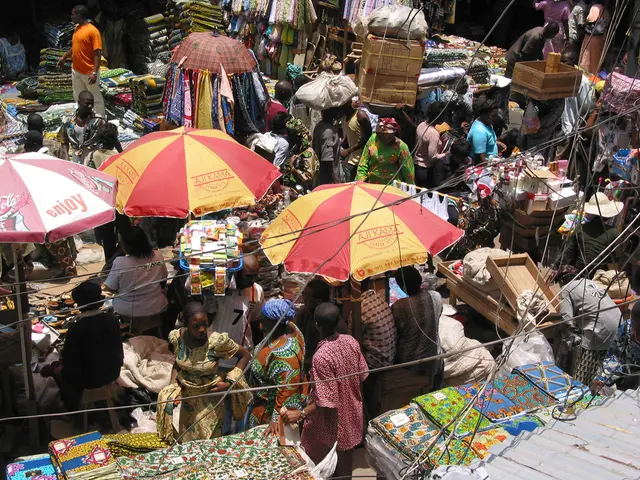The Escalating Energy War: Iran's Energy Facilities Potentially the Next Battlefield
Middle East conflict escalates as oil and power sources confront each other.
By Hannes Vogel
Smoke billows for kilometers over Tehran. Since Sunday night, the largest fuel depot in Iran, situated in Sharan, a wealthy suburb with luxury apartments, has been engulfed in flames. Additionally, one of the country's largest refineries is ablaze 15 kilometers south of the Iranian capital. Moreover, Israeli drones targeted the South Pars gas field over the weekend in Bushehr province on the Persian Gulf, causing refinery fires in yet another attack. This gas field is the world's largest and crucial to the country's energy supply.
This marks a new strategic phase in Israel's air war against Iran, which now targets not just the country's nuclear program threatening Israel's existence, but also its energy infrastructure, air defense systems, rocket launchpads, and Revolutionary Guards' command centers. Prime Minister Benjamin Netanjahu seeks a regime change in Tehran, stating, "a change could certainly be the result" of the war.
Are Iran's Mullahs Leaving?
Oil prices have surged significantly: Brent crude briefly cost over $78 on Monday. Before Israel's attack on Friday, the price was around $70. The perceived possibility of the conflict spreading throughout the Middle East region is causing prices to rise further.
Israel's attacks on Iran are sending a clear message: "It's a warning that nothing is unthinkable." Such a scenario could see Iran, the third-largest oil producer in the Middle East, dropping out as a supplier. Worldwide oil prices could skyrocket as a result. So far, the oil markets have remained relatively stable because Israel's air force has, up until now, spared the critical export infrastructure of Iran, which has been weakened by years of sanctions.
The Next Target: Iran's Central Oil Terminal - Charg
More than 90 percent of Iran's exports pass through Charg, the central Iranian oil depot situated on an island in the Persian Gulf. During the Iran-Iraq War in the 80s, the terminal was heavily damaged by air attacks. If Israel decides to escalate the oil war further, it would be the next logical target for Israeli bombers. After that, supplies would need to pass through another bottleneck: the Strait of Hormuz, which is only about 50 kilometers wide.
The U.S. Energy Agency deems the Strait of Hormuz "the most important bottleneck for global oil transit." The oil artery of the West is within comfortable range of Iranian rockets, drones, and aircraft. Tehran has threatened to close the strait multiple times, potentially cutting off Saudi Arabia's oil exports.
Preventing a Catastrophe
Tehran's calculations might change if the regime becomes "desperate." Historically, pressure on Tehran has led to disruptions in the Strait of Hormuz, as happened during the 1980s "Tanker War" and when Donald Trump tightened sanctions in 2019.ing, when Tehran attacked oil tankers in the Persian Gulf and eventually carried out a drone attack on the heart of Saudi Arabia's oil facilities via the Houthi rebels in Yemen. Five percent of global oil demand was temporarily lost, and oil prices experienced the biggest jump in 30 years.
Source: ntv.de
- Israel-Iran Conflict
- Iran
- Commodity Oil
- Commodity Prices
Enrichment Data:
If the energy infrastructure in Iran becomes the battlefield in the ongoing conflict, several potential global consequences could unfold:
Global Energy Crisis
- Oil Price Volatility: Attacks on Iran's energy infrastructure could lead to significant volatility in oil prices. Historically, such conflicts have caused oil prices to surge, as seen in past events like the 1979 Iranian Revolution[4].
- Supply Disruptions: While current attacks have been calibrated to minimize disruptions, further escalation could impact global oil supplies, especially if Iran targets oil-rich Gulf states or the critical Strait of Hormuz[3][5].
- Global Economic Impact: A prolonged conflict could have a ripple effect on global economies, impacting inflation, trade, and overall economic stability[3].
Regional and Global Political Implications
- Regional Stability: The conflict could lead to instability across the Middle East, drawing in other nations and potentially escalating into a broader regional conflict[2].
- International Relations: The involvement of major powers, either directly or indirectly, could strain international relations and lead to diplomatic tensions[2].
- Proxy Wars: Iran's weakened proxy network could lead to power vacuums in regions like Syria and Lebanon, potentially destabilizing these areas[1].
Humanitarian and Environmental Concerns
- Humanitarian Crisis: Damage to energy infrastructure could exacerbate existing shortages in Iran, leading to humanitarian crises, including food and water supply issues[1].
- Environmental Impact: Destruction of oil facilities could result in environmental disasters, affecting both local ecosystems and global climate concerns[3].
Market and Investment Implications
- Risk Management: Investors may see initial gains in defensive sectors but should be prepared for fluctuations as the conflict unfolds. Long-term strategies might focus on reconstruction and infrastructure development after the conflict subsides[4].
- Sectoral Impact: Certain sectors, like energy and defense, could experience gains during the conflict, while others, such as tourism and consumer goods, might suffer[4].
- Employment policies within the energy sector may need to be adjusted due to the escalating energy war between Iran and Israel, as well as potential supply disruptions and rising oil prices affecting the finance industry.
- The industry and politics are intertwined in this conflict, with global powers potentially becoming involved and diplomatic tensions arising as a result.
- In light of the energy war, it would be prudent for the community to stay informed about general news related to Iran, oil prices, and regional and globalpolitical implications, as this information could impact employment opportunities and investing decisions.








